Immortalising three historic dishes of the Hyderabad trademark cuisine, the Department of Post issued stamps with photographs of the traditional biryani, baghare baingan and seviyan on Friday.
These three mouthwatering dishes will be a pleasant addition to the already existing series of stamps of 24 different Indian dishes, including the famous Tirupati laddu.

The India Post’s love for the country’s distinct and flavourful cuisine also reflects in how Andhra Pradesh’s idli dosa and Pongal also featured in these honorary stamps.
City historians have declared the issuance of stamps a welcome move just in time, as the city celebrates the 500th anniversary of the Golconda Fort and foundation of Qutub Shahi dynasty in the next two months.
Known city historian, Dr Mohammad Safiullah, traced the history of the famous Hyderabadi biryani speaking to the Times of India saying, “Biryani in Persian means fried onion. The fables surrounding the origin of biryani are many.
“Emperor Babar was credited with bringing biryani to north India. In the south, the Qutub Shahis, who were of Iranian descent, introduced several Persian and Turkish dishes. The Asaf Jahis, who were influenced by Mughals, added more dishes to Hyderabadi cuisine.”
He also attributed the enrichment of the Hyderabadi cuisine to the Sufi saints. While the Sufi saints gathered at the `Khanqah,’ (a building designed specifically for gatherings of a Sufi brotherhood), they brought along their own recipes.
At the time, the exchange of several such recipes led to the cooking of new dishes with different flavours. And though many may think the Hyderabadi biryani has Persian roots, the dish became specifically native to the city, only after a dash of local spices worked their magic.
Read more: These Government Schoolgirls in Puducherry Are Generating Electricity From Drainage Water!
Also, the history of the traditional side dish, bagare baingan can be traced to the royal kitchens of Hyderabad.
Vermicelli is known in the Indian Subcontinent, by innumerable local names like seviyan in Hindi, Urdu and Punjabi, valavat or shevaya in Marathi, shemai in Bengali, sev in Gujarati, shavige in Kannada, sevalu or semiya in Telugu, and semiya in Tamil and Malayalam.
Though these thin rice noodles are most commonly used in preparations of are used in some dishes including kheer, a sweet dessert similar to rice pudding, its historic roots are a mystery to cuisine experts. The debate however strongly points that seviyan was introduced into Deccan by the Qutub Shahis and became a part of its cuisine after its inclusion in the Id-ul-Fitr celebrations,
Which delectable dish should India Post feature next? Keep suggesting!
Like this story? Or have something to share?
Write to us: contact@thebetterindia.com
Connect with us on Facebook and Twitter.
NEW: Click here to get positive news on WhatsApp!
We bring stories straight from the heart of India, to inspire millions and create a wave of impact. Our positive movement is growing bigger everyday, and we would love for you to join it.
Please contribute whatever you can, every little penny helps our team in bringing you more stories that support dreams and spread hope.
